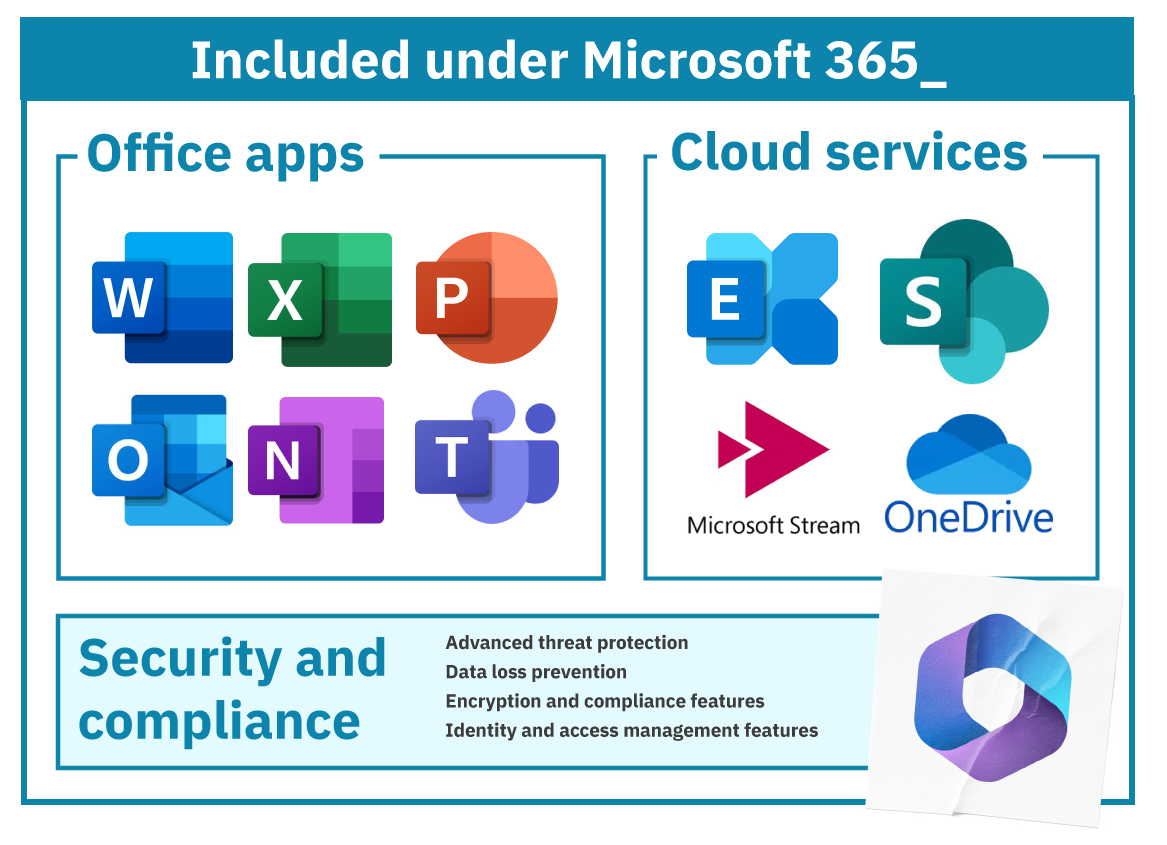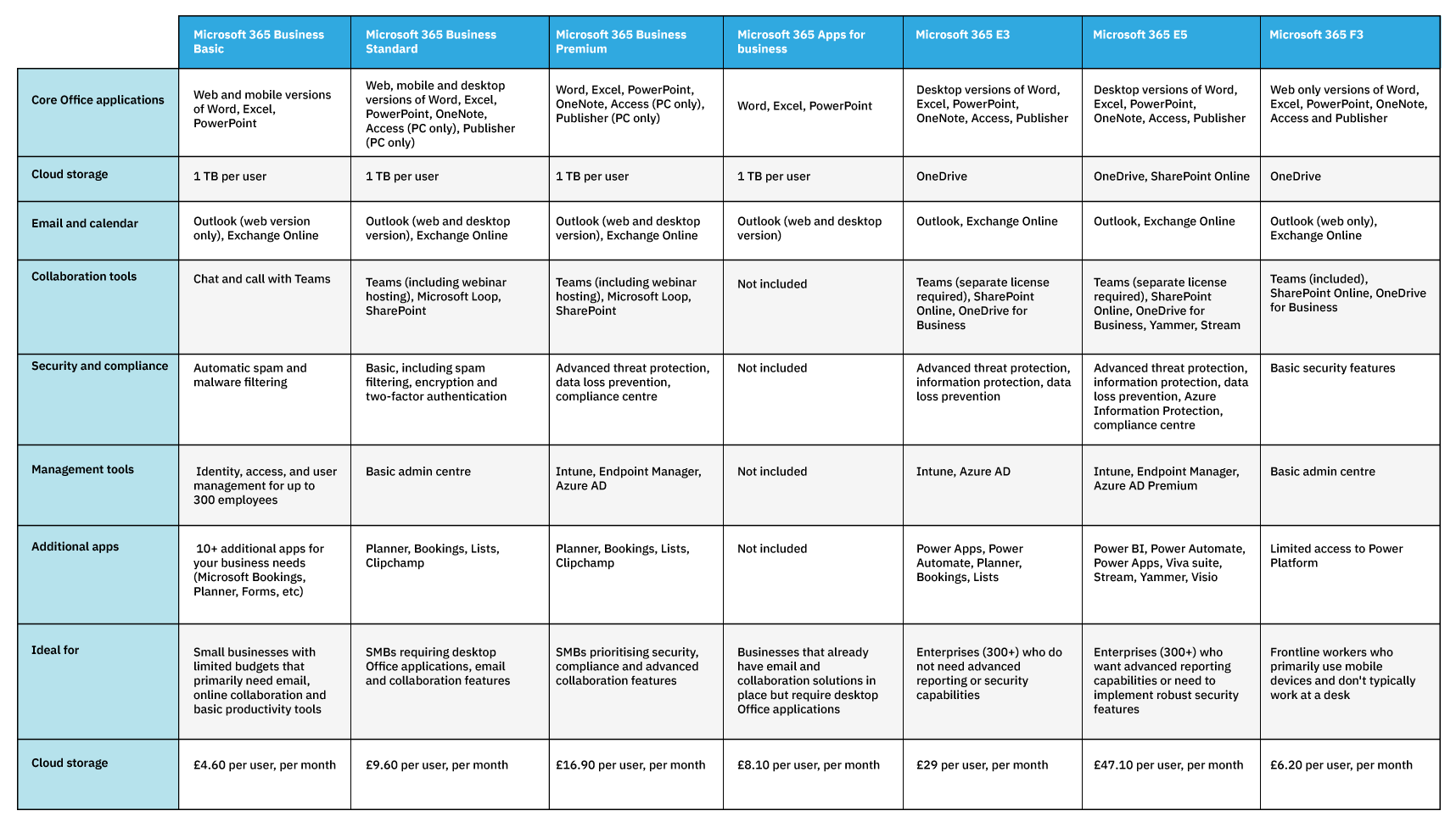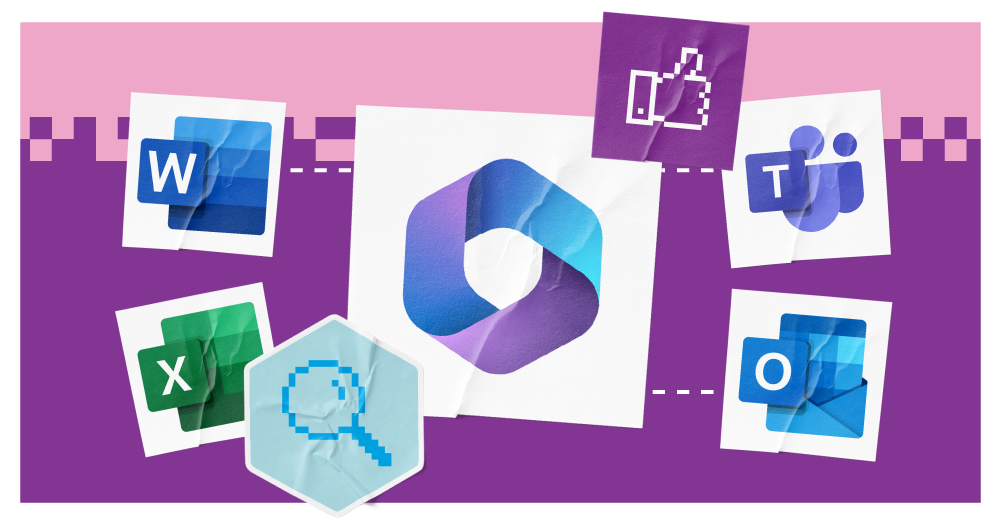Every business needs tools that bring their teams together and enable them to work efficiently. In today’s world, that means reducing any barriers that prevent them from being able to complete tasks, especially where employees are based in different locations.
Microsoft 365 is a suite of applications that connect teams and fuel productivity, while protecting your data with robust security measures. By employing it, you can improve daily working life for your staff, boost business performance and stand out from the competition with high-quality service.
In this guide, we explore everything you need to know about Microsoft 365 and how to successfully implement it in your organisation.
What is Microsoft 365? (and a brief history)
Microsoft 365 is a cloud-based subscription service that provides a suite of integrated applications, services and technologies. It’s designed to empower individuals and organisations to be more productive and collaborative.
It can be useful for a variety of people, including:
- Individuals (including home users and students)
- Businesses (from small to large enterprises)
- Non-profits
The evolution of M365 began with the Office suite, first introduced in 1989. This collection of productivity applications, including Word, Excel and PowerPoint, quickly became a staple for businesses and individuals worldwide. Microsoft launched Office 365 in 2011, offering cloud-based versions of these familiar tools.
In 2017, Microsoft further expanded its vision with the introduction of M365, a comprehensive suite that integrates not only productivity tools but also security, compliance and device management features, to better support organisations and individuals in their modern needs.
What’s included in Microsoft 365?
Microsoft 365 contains many of the famous Microsoft tools we all know and love, as well as some you may not have heard of before. Essentially, it covers anything you need to collaborate, produce and operate effectively as an organisation.
Let’s look at what’s included specifically.

Office apps_
- Word: Providing word processing, document creation and collaboration features
- Excel: For spreadsheets, data analysis and visualisation tools
- PowerPoint: For presentations, slide design and multimedia integration
- Outlook: An email client with calendar scheduling and contact management
- OneNote: Providing digital notetaking, organisation and collaboration
- Teams: Gain real-time communication through chat, video conferencing and file sharing
Cloud services_
- Exchange Online: Offering hosted email, calendar and contacts, allowing staff to be organised and productive
- SharePoint Online: Providing document management, team sites and collaboration platforms for easy access and real-time collaboration
- OneDrive for Business: For cloud storage, file sharing and synchronisation across teams
- Microsoft Stream: A video sharing and collaboration platform
Security and compliance_
- Advanced threat protection: Providing protection against malware, phishing and other common cyber threats that face businesses
- Information protection: Including data loss prevention, encryption and compliance features that enable you to keep business data safe
- Identity and access management: Features such as user authentication, authorisation and single sign-on to simplify access for your teams while keeping unauthorised persons out
Each of these tools brings unique, specific benefits to your business. When brought together under the M365 umbrella, it provides you everything you need to operate and thrive as a business, securely and efficiently.
Why do businesses use Microsoft 365?
Microsoft 365 brings significant benefits to businesses that choose to implement it.
Firstly, it offers enhanced productivity and collaboration. Platforms like Teams enable you to communicate with colleagues in real-time, allowing people to stay connected even from afar. Tools like SharePoint and OneDrive also simplify file sharing and collaboration, so people can work together on documents and get easy access to up-to-date versions.
On top of this, all the solutions under the M365 suite are connected for streamlined workflows. Users don’t need to jump between tools to gain contextual insights or repeat administrative work; instead, they only need to make updates from one tool and see it mirrored everywhere else.
Power Automate and Power Apps can be used to build custom applications and automated workflows that tailor M365 closer to your needs and overcome internal pain points.
By utilising M365, you can also reduce costs related to IT. It is priced at a set monthly cost, making it easier to manage expenses without any surprises. As it’s cloud-based, you can minimise costs associated with maintaining physical hardware and storage. It also cuts administrative overheads.
M365 offers robust security measures to protect sensitive data from cyber threats. When cyber security is often deprioritised, due to a lack of awareness or internal resource, this enables you to operate safely and keep data locked down. This reduces the risk of data breaches and security incidents, which can bring financial and reputational loss, and ensures your compliance with GDPR.
Finally, M365 is an entirely scalable platform, which can evolve with your business needs. It’s easy to add or remove users in line with growth fluctuations. There are also twice-yearly updates across M365 tools, bringing innovation on a regular basis, so you can embrace new trends and tech.
What are the licensing options for Microsoft 365?
Microsoft offer various M365 licensing options for business. We’ve listed the options and what’s included below.
Firstly, M365 licenses can be split into business and enterprise. Business licenses are for those with up to 300 users, while enterprise licenses cover those with over 300 users.
The business options include:
- Microsoft 365 Business Basic: Providing essential cloud-based productivity tools like email, calendar and online versions of Office apps
- Microsoft 365 Business Standard: Includes desktop versions of Office apps, along with collaboration tools like SharePoint and Teams
- Microsoft 365 Business Premium: Offers all the features of Business Standard, alongside advanced security and management tools
- Microsoft 365 Apps for business: Provides desktop versions of Office apps without any cloud-based services
Enterprise options include:
- Microsoft 365 E3: Offers desktop versions of Office applications, advanced threat protection and additional features like Teams and Yammer
- Microsoft 365 E5: The most comprehensive plan, offering all features of E3 plus advanced security, compliance and analytics capabilities, including Windows Virtual Desktop and Azure Information Protection.
- Microsoft 365 F3: Designed for frontline workers, this plan offers access to core productivity apps and services, but with limited features compared to E3 and E5. Any apps included will be exclusively for web and mobile.
The table below compares the license options side-by-side, so you can see the key differences:

Power Apps and Power Automate are also included within these licences, but with limited functionality compared to a full licence.
How to choose the right license for your needs_
Choosing the right Microsoft 365 license for your business involves a careful assessment of your specific needs and budget. Start by identifying the core functionalities required by your employees. Do they primarily need access to core Office applications like Word, Excel and PowerPoint? Or do they require advanced features like enhanced security, device management, and advanced threat protection? This will help you to refine what tools and features you need to perform.
Next, consider the size of your organisation and the number of users who will need access to M365. You’ll also want to consider if everyone needs the same access. This will help you to define how many licenses you need and which option may be best.
You should also assess your security and compliance requirements. If your business handles sensitive data or operates in a regulated industry, you may need a plan with advanced security features such as multi-factor authentication, data loss prevention and threat intelligence.
Finally, consider your budget and explore different licensing options, such as monthly or annual subscriptions, to find the most cost-effective solution for your business.
Consulting with a Microsoft partner can also provide valuable guidance and assistance in selecting the optimal Microsoft 365 license for your specific needs.
How to implement and manage Microsoft 365_
The implementation and management of your Microsoft 365 deployment is crucial for long-term success and ROI. Below, we’ve listed our top tips for starting on the right foot and maintaining it.
Implementing Microsoft 365_
A well-planned implementation is crucial for a successful Microsoft 365 rollout. Here’s a breakdown of key steps:
Planning and preparation:
-
- Start by assessing your current infrastructure. This means evaluating your existing IT infrastructure, including on-premises systems, network connectivity and user devices. This will uncover where you need M365 to be accessible and shape any integrations.
- Next, define your scope and objectives. Clearly define things like the number of users, targeted departments and specific business outcomes you are looking to achieve (such as improved collaboration, enhanced security). This will enable you to tailor your deployment towards these specific goals and understand the project complexity better.
- Finally, plan user training and communication. You’ll need a comprehensive training program for all users, as this will ease the transition and grant faster results. This should include interactive sessions, documentation and ongoing support resources. Aim to plan these early, so it is not forgotten about come launch. You’ll also want to communicate the project to users early, so they are bought in and ready to embrace the change.
Deployment:
-
- Run a pilot programme. This is something we always recommend, as it enables you to test the deployment on a small group of users. Doing so can identify any potential issues or gaps, so they can be rectified before launch. It’s also a great way to get users involved early by recruiting their feedback, which can improve adoption later.
- Next, migrate data. This can be a complex process, including technical know-how and specific tools. It should therefore be planned, so all required data is migrated securely. It may involve cleaning up old files and deciding what you need to move across.
- Finally, onboard users. Create a smooth and efficient user onboarding process, including account provisioning, device setup and initial training. This reduces barriers to usage in those crucial early days, allowing adoption to grow.
As implementation can be difficult, especially if you’re new to the process or have complex requirements, we also recommend bringing in a Microsoft 365 Partner who can guide you through the process and optimise your transition for better results.
Managing Microsoft 365_
Ongoing management is essential to ensure optimal performance, security and user satisfaction. Here are some best practices we recommend to maximise your Microsoft 365 investment:
- Manage users: Regularly review and adjust user licenses based on changing business needs, especially where people leave their roles or new starters require access. It’s worth integrating with Active Directory for seamless user provisioning and management.
- Provide ongoing support: It is likely users will have questions about how to use M365 tools or resolve issues. Seek to establish a help desk or support channels to assist users or consider outsourcing it to an external expert.
- Stay on top of security: Keeping your M365 deployment secure is critical for minimising the risk of data breaches and cyber attacks. Regularly review security alerts and take appropriate action to mitigate threats. It’s also worth enforcing multi-factor authentication for all users to enhance account security. Finally, configure data loss prevention policies to prevent sensitive data from leaving the organisation for enhanced compliance.
- Monitor performance: Monitoring usage can help you uncover adoption rates and progress to your objectives. Track user activity, application usage and system performance within M365 to identify areas for improvement and check it’s being used as intended.
- Regularly update software: Keep Microsoft 365 applications and services updated with the latest security patches and features. Microsoft’s biannual updates can be applied automatically, but you’ll need to configure and plan these across the organisation.
Tips for getting more out of Microsoft 365_
By being able to get more of your deployment, you can maximise ROI while driving efficiency across your organisation. Here are our top tips for increasing the benefits of Microsoft 365.
1. Embrace collaboration tools_
M365 is best known for its collaboration tools, so it’s crucial to make use of them and encourage your teams to do so too. While tools like Teams are known for video calls, there are also features to build collaborative workspaces, such as file sharing, messaging channels and so on. Spend time exploring these and how they can improve your processes.
You should also take advantage of real-time co-authoring capabilities in Word, Excel and PowerPoint to improve team productivity and collaboration. This enables teams to work together on documents, just like they would in the same office.
2. Automate workflows_
Power Automate and Power Apps are two powerful solutions within the Microsoft ecosystem, and they work with M365. Power Automate can minimise repetitive tasks through custom workflows, such as triggering events when specific actions occur. This can allow you to effortlessly do tasks in the likes of Teams and Outlook and reduce time spent on admin.
Power Apps can help you easily build custom applications, such as self-serve portals or engagement tools, which can work in conjunction with M365 tools to ease internal challenges or improve customer experiences.
M365 also integrates with other tools, such as your CRM and ERP systems, to improve data flow. Again, this makes it easier to get full context between apps and saves you needing to input data in multiple places.
3. Power data-driven decision-making_
Power BI connects with M365 to bring your data to life. Insights from the likes of Excel can be turned into engaging visual charts which tell a story through your datapoints, helping you to influence others and share crucial information.
These charts created in Power BI can also be shared back into M365 solutions, including PowerPoint for easy sharing across the organisation.
4. Continuously learn_
Each M365 solution offer advanced features – far too many for us to list. While they won’t all be revolutionary, some may deliver significant benefits for your business and users. Spend time exploring the features available across the suite. Microsoft Learn also provides lots of resources to help you understand how to complete specific tasks and use M365 better.
It’s also worth devoting to ongoing user training and education to ensure employees are effectively utilising the full potential of Microsoft 365. As new updates are rolled out, this will help them to stay up to date and find value.
5. Regularly review and optimise_
Remember to regularly analyse user activity and application usage across your M365 to identify areas for improvement and optimisation. This will allow you to see what is being used and isn’t, which can shape user training or even your chosen license plan moving forward.
You must also review your security settings routinely, adjusting them as needed and checking user permissions and other configurations. This allows you to optimise performance and meet evolving business needs.
Implement Microsoft 365 successfully with Infinity Group_
As one of the largest independently owned Microsoft Partners in the UK, we’ve got vast experience implementing Microsoft 365 for businesses of every shape and size. Regardless of the license plan you choose, we can help you to discover, customise and implement your deployment so it delivers long-lasting rewards.
Covering the design of your deployment, data migration, project management, user testing, security configuration, licensing and more, we provide all the support you need to get buy-in and successfully embed Microsoft 365. We can even support you with the long-term management.
And if you’re not sure if M365 is the right tool for you, or what license plan you need, not to worry. We can guide you through that too!
Just get in touch to speak to one of our consultants with a no fee, no commitment call.




